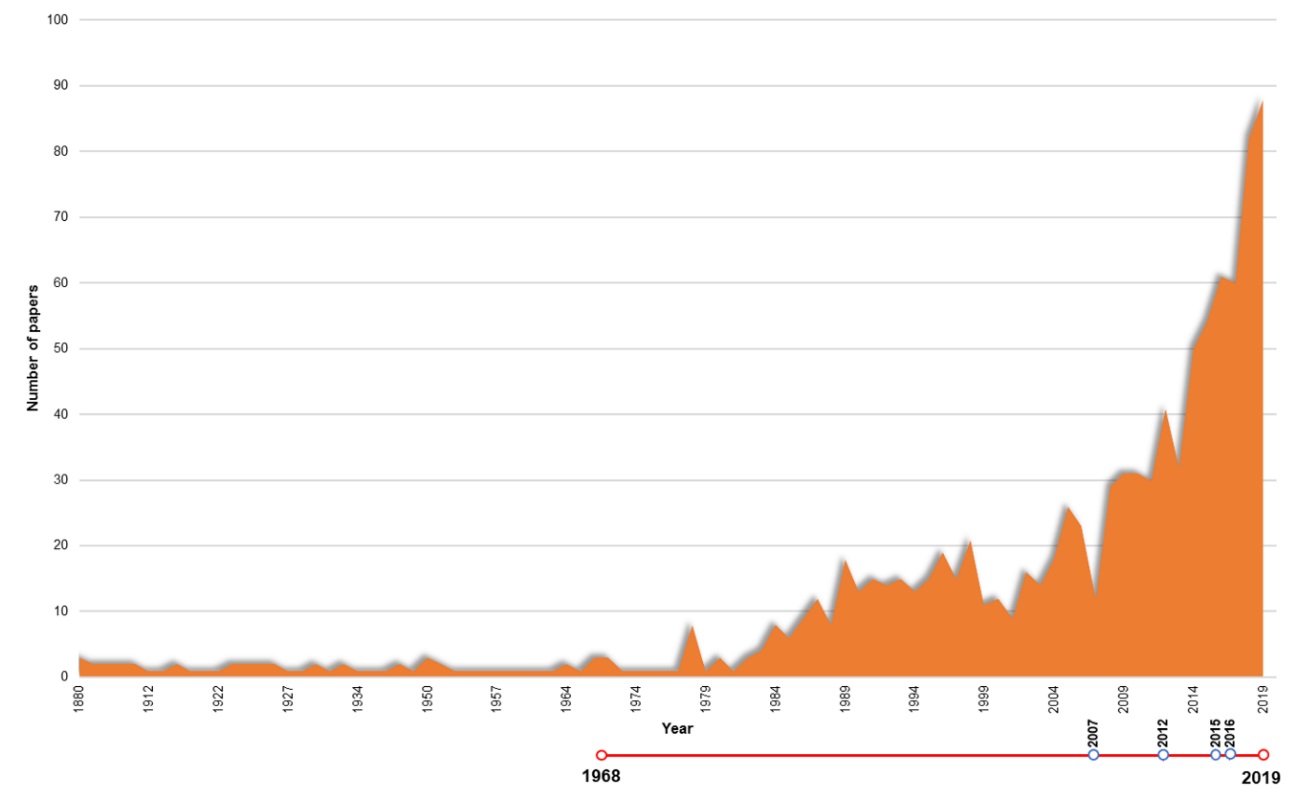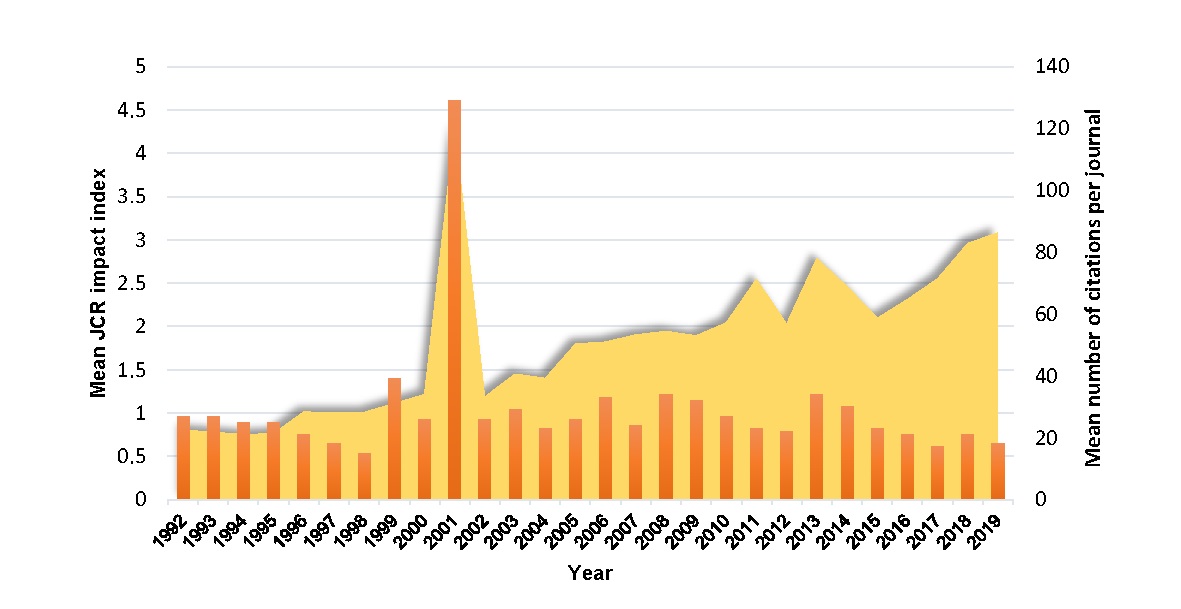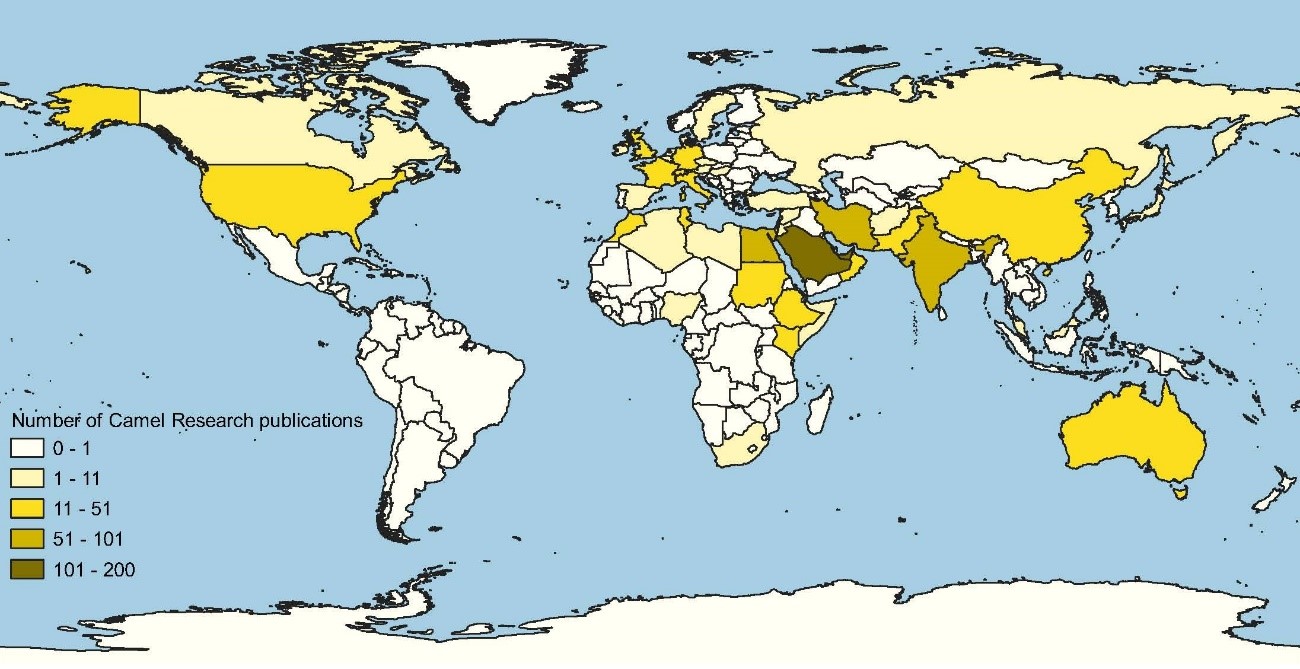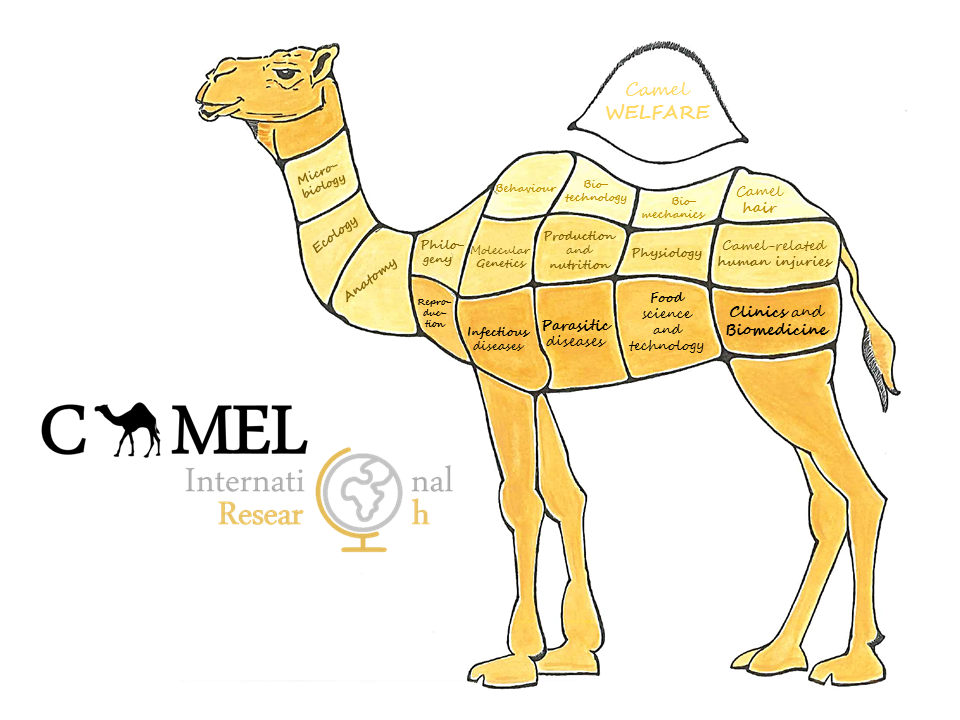Minor species such as camels are lacking for transactional agreements between applied research and regulatory agencies in regards of animal welfare. Given these species being progressively recognized as sustainable livestock even under extreme environmental conditions, camel international science has brought about valuable academic efforts towards its functional revalorization but not updated policy reforms. By means of bibliometrics analysis, camel science upturn and its academic and societal impacts were evaluated to highlight the potential promoting factors for camel research advances and specific parallel law enforcing. Historical camel referring documents that were indexed in ScienceDirect directory from 1880-2019 were considered. Camel as a species did not affect research impact (p > 0.05) despite the journal, author number, corresponding author origin, discipline and publication year affecting it (p < 0.001). However, camel welfare-related laws remain scarcely available. In this framework, research advances must play a cardinal role in influencing business stakeholders and animal welfare advocacies to promote sustainable camel husbandry practices through science-based law enforcement in this emerging industry on a global scale.
- Animal welfare
- bibliometrics
- camels
- emerging industry
- international research
- science-society dialogue
1. Introduction
Camels (Camelus dromedarius or one-humped camel, Camelus bactrianus or two-humped camel and the wild species Camelus ferus) may have been the most ignored species compared with other domestic livestock from a productive, political or socioeconomic perspective. Fortunately, their international relevance has progressively increased due to their recognition as a multifunctional resource for humans with very low maintenance requirements even under extreme environmental conditions [1][2][3]. Additionally, the biomedical applications of some of their derived products [4] and their potential for animal-assisted therapeutics [5], are reinforcing criteria for such emerging camel cultural relevance and social appreciation.
2. Data
These growing economic interests in camel husbandry experienced during the past three decades [2] has led to an increase in the academic actions implemented and which deal with almost any discipline applied to the species (Figure 1). This academic upturn is simultaneous to an increase in worldwide camel census [6][7] and ratified by the upward positive trends in camel science impact specially since the beginning of the present century (Figure 2). The year of publication factor reported significant differences (p < 0.005, df = 85, as no impact factor had been registered for any of the journals before 1992) between the academic impact from papers published in the early and mid-20th century and those published since 1990 (especially those from 2000 to 2019).
Figure 1. Number of camel research publications from 1880 to 2019. Timeline is represented below the graph in red, with blue-contoured spots marking the moment of release of a regulation document.
Figure 2. Mean JCR impact index and mean number of citations per year between 1992 and 2019.
The countries that first paid attention to these animals’ productive potentialities and addressed challenges/constraints in camel commercial distribution chain, were those in which a previous tradition forged in camel breeding and production existed, with the benefits derived from the species occurring at both an economic and socio-cultural level [8]. Significant differences (p < 0.05, df = 55) were found between academic impact for papers whose corresponding author were from central and north-east European and those coming from Asian and North African countries. That is, eastern Africa and Middle Eastern countries reached both the higher number of publications (Figure 3) and mean impact indexes. In this context, demographics, institutional prestige of the corresponding author, the involvement in world-level cooperating projects, the number of authors and their degree of specialty, could also act as potential conditioning factors for submitted manuscript outcomes [9].
Figure 3. Quantum Geographical Information System (QGIS) map displaying the number of camel research papers per country.
When camel species conditioning effect was examined, this factor appeared not to statistically significantly influence research impact in camel science. Nonetheless, if frequencies are compared, the number of publications for which Camelus dromedarius was the species studied was substantially higher than those for Camelus bactrianus and Camelus ferus. This could be explained by the existence of a greater number of animals in the African continent in agropastoral systems according to published censuses [10], which allow the scientific community access to a high number of domestic dromedaries and facilitate its management and planning of cooperative research studies.
Regarding the average impact among research topics, the greatest advances in camel international research were produced in the areas of Food Science and Technology, Camel Health (Infectious and Parasitic Diseases), Camel Reproduction and Clinical and Biomedical Research. For the latest, as an emerging research topic due to its radical novelty and relatively fast growth, the number of published papers were high but their academic impact remains low. This finding remarks the need for standardization of related methodologies as a previous step for increase the visibility of this promising research field within the scientific community and the success of the therapeutical applications of camel derived products. Figure 4 shows the frequency distribution of specific topics in camel international research.
Figure 4. Specific topics in camel international research. Color intensity is relative to the number of publications in each scientific area. The darker the color, the higher the number of publications dealing with that topic.
In summary, widely applied scientific knowledge about anatomy, physiology and pathology in camels can be found in the literature. Instead, topics such as nutrition, ecology, behavior physiology, genetic management and production are scarcely approached [11]. In turn, planned research and codes of action on the best handling practices ensuring a sufficient welfare status in these animals are scarce and shallow [12], that can be ascribed to the close relationship between animal wellbeing and food-producing systems and the emerging scenario of this industry. In other words, camel production-related topics must be urgently reoriented and assessed due to production–health–welfare complex interactions.
3. Camel welfare-related law enforcement
Social awareness is grossly affected by science and vice versa, as the binomial science–society is immersed in a process of diachronic evolution with a sufficiently proven cultural base. In the absence of quantitative information regarding the level of camel welfare in different housing systems, intentional harming acts and basic needs neglect may persist in these species and their productive potential might be devalued.
Aiming to reach a consensus on camel wellbeing, science must primarily revise the existing legislation to identify the changes needed to adapt them to the emerging challenges that this rather overlooked multipurpose species faces nowadays. Thus, research outputs may encourage lawmakers to develop and constantly update official mandatory regulations as well as highlight the need for expanded awareness when aiming to meet new societal values and expectations [13].
Specific regulations and guidance concerning the welfare of reared camels are noticeably limited [14]. The World Organisation for Animal Health (OIE) ‘Terrestrial Code’[15] contemplates camels as livestock and thus has provided concrete welfare recommendations since its first edition in 1968 until the present. It defines general protocols and standards for camel transport, their slaughtering process for human consumption and some specific concerns applicable to specific diseases. This ‘Terrestrial Code’ includes specific chapters detailing animal-based criteria or measurables that can be useful indicators of animal welfare for cattle, chicken, equid and pig depending on production systems in which reared, from birth through to finishing; for camels, this information is lacking.
At a national level, mandatory regulations that categorically include camels as goods-production livestock and promote its welfare were solely endorsed in four countries around the world, from 2007 to 2016 [16][17][18][19]. These national laws present a brief, technical-based approach for basic physiological needs satisfaction and handling practices during transportation and slaughtering, both with farmed and feral camels. Although this limited law enforcement is simultaneous to camel science upturn, such findings provide again insight into the need for camel international research to be reinforced in closely related topics (production, ecology and behavior physiology). That is because the OIE standards are based on the most recent scientific articles in light of advances in veterinary science and encourage nationally competent authorities to promote legislative adaptations when necessary.
4. Conclusions
Under this framework, we conclude that, while innovative legislation is being drawn up, the scientific community plays a pivotal role when make livestock producers consider the positive effects of animal wellbeing on production rates and the public’s perception of this livestock industry. For this purpose, the countries where camel censuses are significantly higher and the world’s highest-ranked research institutions in camel science, are expected to constitute solid collaborative conventions in camel welfare investigation on a global scale. These consortia could use its direct empirical experience derived from the analysis of large samples to maximize the validity of their conclusive results and thus improve the resultant regulations’ promotion and updating.
This entry is adapted from the peer-reviewed paper 10.3390/ani10050780
References
- [1] Yagil, R. Camels and Camel Milk; FAO: Rome, Italy, 1982.
- [2] Khan, B.B.; Arshad, I.; Riaz, M. Production and Management of Camels; University of Agriculture, Department of Livestock Management: Faisalabad, Pakistan, 2003.
- [3] Acharya, K.P.; Pathak, S. Applied research in low income countries: Why and how? Front. Res. Metr. Anal. 2019, 4, 3.
- [4] Alebie, G.; Yohannes, S.; Worku, A. Therapeutic applications of camel’s milk and urine against cancer: Current development efforts and future perspectives. J. Cancer. Sci. Ther. 2017, 9, 468–478.
- [5] Parish-Plass, N. Animal-Assisted Psychotherapy: Theory, Issues, and Practice; Purdue University Press: West Lafayette, IN, USA, 2013.
- [6] Faye, B.; Chaibou, M.; Vias, G. Integrated impact of climate change and socioeconomic development on the evolution of camel farming systems. Br. J. Environ. Clim. Chang. 2012, 2, 227–244.
- [7] Faye, B. The camel today: Assets and potentials. Anthropozoologica 2014, 49, 167–176.
- [8] Wilson, R.; Bourzat, D. Past, present and future research on the one-humped camel in Africa. J. Arid Environ. 1988, 14, 1–15.
- [9] McGillivray, B.; De Ranieri, E. Uptake and outcome of manuscripts in Nature journals by review model and author characteristics. Res. Integr. Peer Rev. 2018, 3, 5.
- [10] Faye, B. Role, distribution and perspective of camel breeding in the third millennium economies. Emir. J. Food Agric. 2015, 27, 318–327.
- [11] Wardeh, M.F. The camel applied research and development network. J. Arid Environ. 1994, 26, 105–111.
- [12] Fattah, A.F.A.; Roushdy, E.-S.M. Productive performance and behaviour of calf camel (Camelus dromedarius) under semi-intensive and traditional rearing system. Benha Vet. Med. J. 2016, 31, 85–91.
- [13] Reblando, J.R. Social changes’ impact on the creation of new social and legislative rules and norms. Int. J. Novel Res. Interdiscip. Stud. 2018, 5, 1–3.
- [14] Previti, A.; Guercio, B.; Passantino, A. Protection of farmed camels (Camelus dromedarius): Welfare problems and legislative perspective. Anim. Sci. J. 2016, 87, 183–189.
- [15] World Organisation for Animal Health. Terrestrial Animal Health Code, 28th ed.; World Organisation for Animal Health: Paris, France, 2019.
- [16] Tunisian Ministere de l’Agriculture et des Ressources Hydrauliques. Conditions Techniques et Sanitaires pour le Transport des Animaux Concernés par l’Identification; Ministere de l’Agriculture et des Ressources Hydrauliques: Tunis, Tunisia, 2007.
- [17] Government of South Australia. Animal Welfare Regulations; Attorney-General’s Department. Government of South Australia: Adelaide, Australia, 2012.
- [18] Government of Canary Islands. Circular de 13 de Marzo de 2015, por la que se dictan Instrucciones para el Transporte de Animales de la Especie Camelidae (Dromedarios) en la Comunidad Autónoma de Canarias; Dirección General de Ganadería: Canary Islands, Spain, 2015.
- [19] USA Department of Agriculture, Animal and Plant Health Inspection Service. Animal Welfare Act; Department of Agriculture Animal and Plant Health Inspection Service: Riverdale, MD, USA, 2016.




